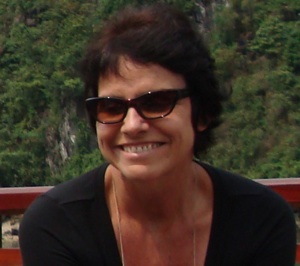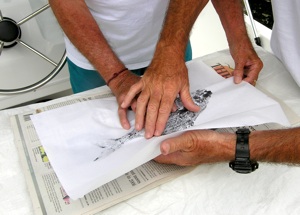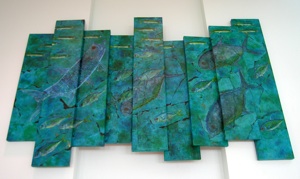Kim Workman: The Art of Fish Rubbing
By Christina Baez, Florida Keys News Bureau
Some people are dedicated to catching fish, while others are dedicated to eating fish. Keys artist Kim Workman, however, has dedicated most of her adult life to rubbing fish to create unique images.
Rubbing fish? The concept is mind-boggling to most in the Western world but this technique, known as gyotaku, has been around for centuries in the Japanese culture. Named combining the words gyo meaning "fish" and taku meaning "rubbing," the art form originated in the mid-19th century as a way for Japanese fisherman to record the size of their catch.
Typically, the gyotaku process begins with placing the fish on a wooden bench then painting it with black sumi ink. White rice paper is then pressed over the fish and rubbed gently. When the paper is lifted, an exact black ink positive image is revealed. Workman enhances her fish images by adding watercolors.
While black ink on white rice paper is the traditional method of creating gyotaku, Workman and her late husband Ian evolved the traditional art form into a process they referred to as Kimian.
"Although both of us could print and paint, Ian did most of the fish rubbings and I did the paintings in bright bold colors," Workman said. "Because we created the art together we signed it combining our first names, Kimian. We called it 'two arts beating as one.'"
The daughter of a marine conservationist and descendant of a long line of pioneer shrimpers, Workman is a true sea-loving artist who grew up on America's Gulf Coast.
"That great love of the sea was passed on to me," she said. "Whether it was from childhood experiences or genetically inherited, the sea flows through my veins as it did my ancestors'."
Workman discovered her talent for art at the age of 8 when she doodled on a chalkboard out of boredom and her family praised her talent. She won many art competitions, with nature often being part of her creations.
Though Workman studied many art forms throughout her life, as an adult she pursued another career. She owned a health club for 20 years and dedicated most of her time and energy to fitness.
Workman's husband Ian was a marine biologist who shared her love of the sea and fitness. He even proposed marriage to her while they were scuba diving in Cozumel, Mexico.
"Ian drifted past me holding a slate with the written words 'will you marry me?'" Workman recalled. "Surrounded by beautiful coral and breathtaking tropical fish, I nodded yes."
The couple married and opened a dive shop adjacent to Workman's health club, while Ian also worked as a fishery biologist for the National Oceanic and Atmospheric Administration.
Workman rediscovered her love of art in the early 1990s when Ian introduced her to gyotaku, a process he studied in college for scientific purposes. The couple's gyotaku paintings became so successful that they opened a gallery in 1992.
Shortly after that, the Workmans began making frequent trips to the Keys. Ian came for his work as a marine biologist, while Kim visited to print and paint fish.
"The Keys are so different from the Gulf Coast," Kim Workman said. "I had never seen water so beautiful in the U.S. as it is in the Keys."
The couple purchased a home on Cudjoe Key in 2000, settled in permanently in March 2003 and spent every waking moment in and on the water.
Word quickly spread that they were taking freshly caught fish and making trophy art prints from them. Soon, Kimian art made its way into local galleries as well as hospital wings, restaurants and private collections.
In 2008, the Workmans were commissioned to create a large piece for the then-new Key West International Airport terminal.
The Kimian sculpture that now graces the terminal was the last piece the couple created together, and remains dearest to Kim Workman's heart. Ian fell ill in October 2008 and died July 4, 2009.
"I took a break from painting and printing for six months and wondered if I could ever paint again. I found I could and I did," she said. "I knew Ian would be angry with me if I didn't."
Workman rediscovered her artistic passion in 2010 on a trip to Japan where she studied with master gyotaku artist Mineo Yamamoto. She also went to Singapore and taught a gyotaku class to schoolchildren and traveled in Vietnam, Cambodia, and Malaysia with paper and ink.
Since returning home, Workman has focused on expanding her art beyond simple prints, and says she enjoys creating gyotaku-inspired sculptures and more. Today, her art can be found at several Keys galleries.
"I love traveling, but there is no place like home in the Keys," she said. "The Keys, with water that is the color of lime Jello and those beautiful reefs that can only be described as indescribable."

Workman rediscovered her artistic passion in 2010 on a trip to Japan where she studied with a master gyotaku artist.

The art of gyotaku involves taking freshly caught fish and making trophy art prints from them.

In 2008, the Workmans were commissioned to create a large piece for the then-new Key West International Airport terminal.
